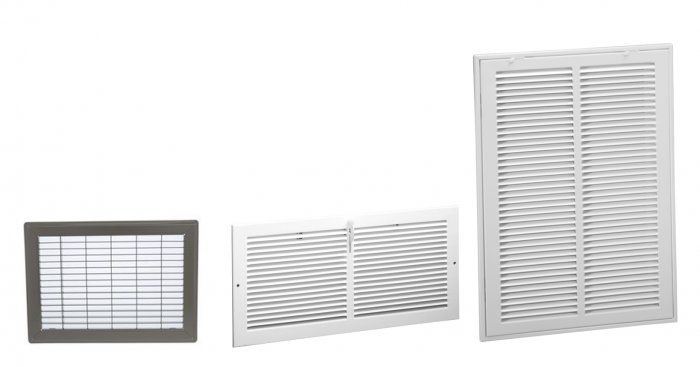
Grilles, registers, and diffusers (GRD) occur at the interface between the ductwork and the living space. Their placement is usually dictated by habit and convenience, and the selection of specific products is often thought of primarily as an aesthetic choice. However, GRD can significantly impact comfort, efficiency, and noise levels. In part one of this series, I’ll explain the differences between grilles, registers, and diffusers and look at where decisions about GRD fall in the HVAC design process. I’ll also discuss placement and product selection considerations for return grilles. In future articles, I’ll look at room-to-room transfer grilles, supply registers, and diffusers.
Differentiating between components
GRD are perforated or louvered fittings that cover openings in the supply and return ductwork. They allow air to flow through them and influence the velocity and direction of conditioned supply air. They provide a finished look and keep large objects out of the ductwork (although, in homes with young kids, floor grilles and registers often serve as collection points for small toys, pennies, and breakfast cereal).
The terms “grilles,” “registers,” and “diffusers” are often used interchangeably. I find it useful to distinguish them as follows:
Grilles are square or rectangular fittings without adjustable dampers. They usually cover return openings. They can also allow air to flow out of rooms that lack return ducts and, more rarely, to cover supply openings. Lightweight stamped steel grilles are common in wall and ceiling applications. Sturdier cast or welded grilles are suitable for use in floors. Filter grilles, used in walls and ceilings, are hinged to allow access to a built-in filter rack.

Registers are square or rectangular fittings with movable dampers to adjust airflow volume. They are generally used…
Weekly Newsletter
Get building science and energy efficiency advice, plus special offers, in your inbox.

This article is only available to GBA Prime Members
Sign up for a free trial and get instant access to this article as well as GBA’s complete library of premium articles and construction details.
Start Free TrialAlready a member? Log in















5 Comments
I repeatedly find myself reading Jon's blogs even though they often aren't relevant to what I do, simply because they are so comprehensive and fascinating.
Agree. There have been more than a few of his articles that I really wish I'd had several years earlier! :-)
Thank you both! I really appreciate the kind words.
I use lower MERV rated filters in my 2 returns and a higher MERV rated filter at the air-handler. My thoughts are that the lower MERV filters catch the big nasty stuff without causing the air-handler to work too hard sucking air through multiple thick filters, while the one in the actual unit really does need to be doing heavy duty . Is this thinking valid? I'm just a homeowner.
Also, I regret not asking the HVAC tech to size the returns equally to make shopping and storage easier.
I am happy that I didn't put any registers in the floor for the reasons mentioned, plus gravity just (I think) lets more gunk and dust fall into something sitting flat on the floor.
The risk with having multiple filters in series is that the pressure drops (resistances) are cumulative. You may end up hurting airflow and shortening the life of the fan, heat exchanger, or other components. You will be better off using a single filter. Thick pleated filters can combine good filtration with acceptable pressure losses. Because they have so much surface area, they can withstand larger particulate loading, so are often good for several months, versus weeks for many 1" filters.
Log in or become a member to post a comment.
Sign up Log in